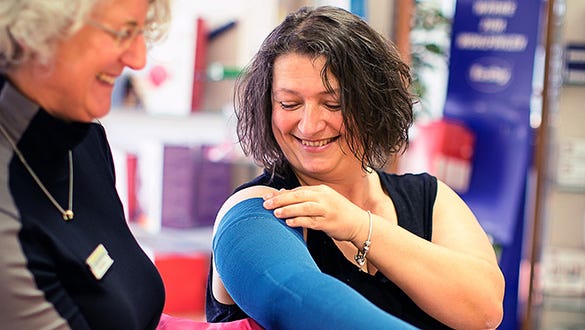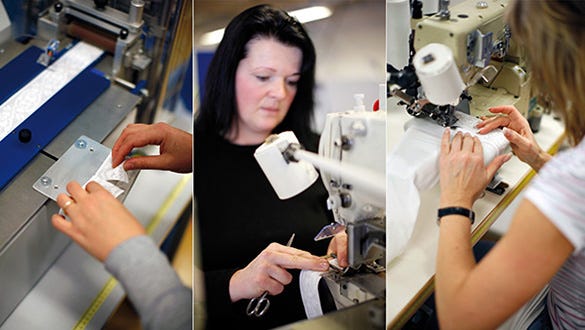- Free First Class Delivery
- Buyer Protection
- Secure Online Shopping
- Healthcare Professional? Click here
Small guided tour of our head office manufacturing plant in Germany


Categories
A virtual guided tour around our stocking production area
Many hands work together at medi to create a compression garment – as is shown in this short video below, taking mediven elegance as an example.
Production runs like clockwork, with the various production stages in every department slotting into each other like wheels in a cog, highlighting once again what's behind "Made in Germany": real teamwork.
The "raw materials" arrive: as soon as the yarn arrives, the consignment is inspected meticulously:
are the goods all there and in perfect condition? Does the delivery slip tally with the goods? Only then are the goods signed off and entered in the inventory program.
All there? Everything OK? Each box has to pass the visual inspection before the green light is given and the yarns are transported to the knitting hall. Only the very best "ingredients" are approved for stocking production.
Off to the round knitting hall this is when the yarn becomes a stocking. The yarn is threaded onto the knitting machine's round knit cylinder. This needs a steady hand and plenty of fine motor skills – precision work before the knitting even starts.




4,500 stitches per second: the speed at which the threads circle the knitting cylinder makes them unrecognisable to the naked eye.
6.4 minutes later: the mediven elegance "stocking tube" drops into the hopper. All round knit stockings are knitted in white. The garments don't get their final appearance until they have been dyed.
910,888 stitches later: two sample stockings have to pass the longitudinal and transverse stretch tests before the machines start making up the order in earnest.
The perfect mesh structure: The stocking is now pulled lengthwise over the inspection board. A practiced eye immediately recognises any irregularity that may have crept into the mesh structure, for example, if the compression yarn is coming to an end after 30,000 metres or if the knitting yarn is beginning to run out after 100,000 metres. There are no compromises in terms of quality – anything that's not perfect is simply rejected.
Temporary storage: The stocking is then moved into temporary storage. The production operating system automatically consigns a storage site until the stockings are moved to the finishing department for further processing.




Closing off the toes: Next the finishing off of the toe section of mediven elegance stockings by hand with the sewing machine, sewing them in a semi-circle form. This needs a steady hand and a great deal of experience.
The next inspection: another inspection phase: mediven elegance is then pulled over the inspection board and the mesh structure of the heel and the toe is inspected.
Preparing the topband: A machine is used to cut the topband to length. The topband strip is threaded into the machine and the length and number of topband sections are entered. Particularly important: the cut edge has to be absolutely straight for the next production stage.
Sewing the topband together: The topband ends are now sewn together. The cut edges are precisely matched so that they are flush with each other and the topband is "binded". Even the tiniest loose threads are cut off by hand with a pair of sharp scissors. This is perfection to the tiniest detail for mediven elegance.
Sewing on the topband: The topband is sewn next, exactly edge to edge onto the compression stocking. Because there is no overlap, the transition from the topband to the stocking is inconspicuous – even under tight clothing. The topband seam is now over the back of the leg exactly in line with the heel. The elastic seam follows the wearer's every movement. Every loose thread – no matter how tiny – is carefully snipped off. Handicraft is indispensable here at medi.




Making the labels: The labels include all the details of the stocking (size, length).
Printing the labels: they are printed on an endless textile reel and enclosed with the stockings.
Sewing the labels in: A row of labels are then threaded into the special sewing machine. The stocking is now pressed against the label, which is then automatically sewn in and cut off. The stocking now has its very own personal "ID card".
Now to the dyeing and the finishing touch: this is where the mediven elegance stocking becomes colourful. Here the stockings are inspected and stacked them up.
And off into the dyeing machine: The stack of stockings is placed in the dyeing machine. The dye mixture is poured in, the machine is programmed and started. It is checked several times during the dyeing process. The dyeing machine is running. The running time depends on the colour: pale colours are finished sooner than dark shades




Environmentally-friendly dyeing: the dye is so harmless that it can be run off directly into the wastewater system. The stockings are then washed, dried and laid out. The machines are heated by steam from the drain water heat recovery system.
And yet another inspection: before the compression stocking is popped into the box, another check is carried out checking the length of the stocking and the details on the label.
Information material: all the information that the patient needs to know is now packed in the box too. The compression stocking is folded and wrapped in tissue paper together with the information leaflets (Instructions for Use, mini medi Info).




Ready for the long journey: the stocking cartons are first stored in our magenta boxes. The box is covered to protect the cartons. T box data is scanned, the inventory in the operating system is automatically updated and awaits dispatch instructions.
It's a fascinating process, the journey from yarn to stocking. We hope you enjoy your "virtual guided tour around our stocking production area".






